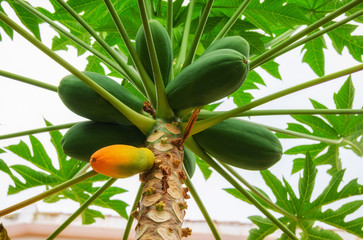
A medium-sized tree, the cultivation of the Papaya tree is common in many tropical regions. Its straight, cylindrical trunk is capped with a large bouquet of palmate leaves.
The fruit of the Papaya or Papaya, of greenish blue color is of an ovoid shape, close to the pear of our gardens.
All the anatomical parts of the tree contain a whitish latex. It is the latter, after drying and purification, that WURTZ and BOUCHUT described and named in 1870 papain.
Like bromelain (the pineapple enzyme), papain has the ability to digest proteins.
This has long been used in tropical countries to preserve the meat which was then wrapped in papaya leaves.
Latin name: Carica Papaya
Family: Passifloraceae
Origin: Molluscan Islands, tropical countries
Part used: Fruit, latex contains papain
Activities:
- Traditionally used to aid digestion and weight loss.
- Tackles the tissue retaining fatty deposits and promotes their dissolution
Contraindication: Do not use in children under 15 years
Alternation: Ananas
